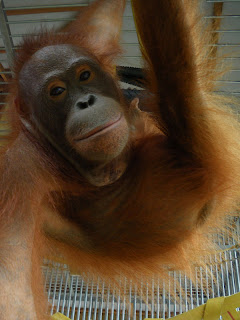 Nicky is a female of about 6 years old. We took her in in April 2009. A family had bought her and when she started to grow they left her running loose around the family property.
Nicky is a female of about 6 years old. We took her in in April 2009. A family had bought her and when she started to grow they left her running loose around the family property. Nicky was rescued from her life in the city and taken to the centre to learn to live like an orangutan.
Now Nicky shares an enclosure with Mona and she likes to play using the sacks we give them for enrichment and to hide inside one of them while Mona tries to get her out.
She loves interacting with her next door neighbours Jojo and Jingo too. They play together all the time, trying to catch each other's hands through the bars and passing one another branches or other enrichment materials through the bars.




